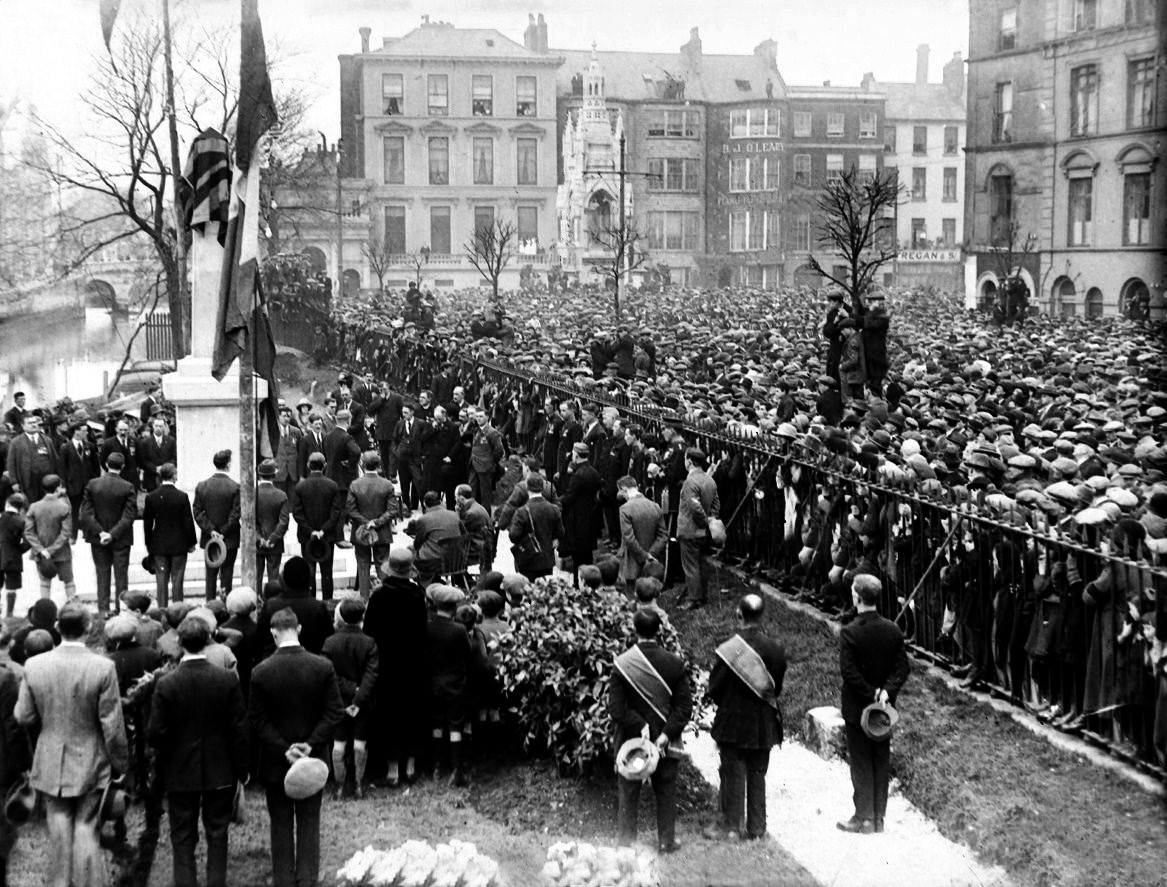Writing the Irish back into the First World War
Niamh Gallagher
In April 2013 I was fortunate to meet an inspiring group of soldiers from the Irish army in County Cork in southern Ireland. They were part of the Cork Western Front Association and all had relatives who had served in Irish regiments of the British Army during the First World War. One of my guides, Adrian Foley, showed me the image shown below. The picture is from a cracked glass plate which Adrian found hidden under piles of rubbish in one of the local museums. It shows the turnout of people at the unveiling of the city’s war memorial in March 1925. If you look carefully you will see more than just a mass of people. Surrounding the memorial are ex-soldiers, many of whom had been in the local British infantry regiment, the Royal Munster Fusiliers, holding their hats in their hands as a mark of respect to comrades who had fallen in action; women and children are standing behind them, and local dignitaries can be spotted by their characteristic sashes and wreaths. But there are two very striking features that stand out about the rest. The first is the crowd, packed from one end of the street to the other in a widespread demonstration of mourning and remembrance. The second is the flags: the republican tricolour in the foreground symbolizing Ireland’s independence from Britain, which was achieved in December 1921, and, remarkably, the Union Flag draped over the war memorial.

On the one hand this image could be interpreted as one of the many demonstrations of remembrance which occurred across the United Kingdom and European continent in the aftermath of the First World War. But among these acts this example stands out because it appears anomalous when put in the context of historical writing about the county and city. During the course of the twentieth century, Cork became known for the stand it took against the British during the 1919-21 conflict, often called the Irish War of Independence, which brought about an end to the 1801 Acts of Union under which Ireland was subsumed within the United Kingdom. It is also known for its ardent republicanism during the civil war of 1922 to 1923, in which Irish nationalists were split over whether or not to support the treaty signed between the new Irish representatives, Sinn Féin, and the British government led by David Lloyd George, over the terms of independence (Cork was generally known for its anti-treaty stance in this war. It even earned the nickname of ‘rebel Cork’ and for a time declared itself its own republic in protest against the agreement with Westminster). From 1917-1923, 747 people were killed for political reasons in Cork city and county in the struggle over self-government. This photograph of remembrance for a war in which Irishmen had mainly served in the ranks of the British armed forces did not align with the narrative of independence still associated with the city today.
The anomalous quality of this moment in time piqued my interest in the history of the Irish ‘home front’ in the First World War. I later discovered that Cork was not the only city to have had such a seemingly incongruous past. The historiography of wartime Ireland had generally concluded that Irish nationalists, who were largely Catholic, were steadfastly against the conflict, particularly once the movement for independence got underway. British history of wartime Irish nationalism was not much better, as the Irish were frequently forgotten about (despite the fact that the United Kingdom went to war in 1914, not the island of Britain); when they were remembered, nationalists made cameo appearances as detractors of the war effort, as pro-German sympathisers, and as terrorists in the aftermath of the 1916 Easter Rising, intent on destroying the Union.
Neither of these views allowed space for the multiple demonstrations of individual agency depicted in this photograph or in the other episodes of mass mourning witnessed in the decades following independence. Instead of taking Irish independence as my starting point and projecting back to discover the series of events that led to the constitutional changes of 1920-21 (and the important political changes which happened between the Easter Rising and the conclusion of the civil war in 1923), I therefore chose to focus on the attitudes and actions of people involved in the war effort, as well as the contingent events that influenced their behaviour. By paying close attention to chronological change, I was able to explore exactly how multiple groups engaged with the war effort and how their attitudes evolved over time. Furthermore, in 1911 over one third of Irish-born people lived outside Ireland due to sustained and persistent emigration since the devastating famines of the 1840s. Substantial diasporic communities had developed across the former British Empire, and in the First World War many Irish settlers served in the Dominion armies, where Irishness remained at the forefront of their identities.
By changing the focus to include both the Irish in Ireland as well as case studies of the Irish abroad, I discovered that Irish Catholic support for the Allied war effort was considerably greater than orthodox histories had suggested. I also found that Protestants and Catholics, usually pitted against one another in most histories of Modern Ireland, actually collaborated in a variety of ways to assist the war effort, from middle-class women’s involvement in war-work to the shared community responses to devastating episodes such as the sinking of the RMS Lusitania in 1915. This photograph is one of the numerous instances of a shared sense of solidarity created between members of both communities that endured beyond the Armistice of 1918: a solidarity that has been absent in almost every other history whose research focus has included the war years.
Over five per cent of Cork’s total male population (both the city and county) are thought to have served in the First World War and ex-servicemen likely comprised more than one fifth of the city’s population by 1924 (i.e. 16,000 men out of a population of 76,673). During the conflict, 3,774 men with tangible connections to the city and county were killed. This was more than five times as many killed in the struggle for independence. One cannot measure the contribution of women, men who did not (or could not) join the ranks, and children in the voluntary war effort, but a Red Cross report from 1921 declared that the war-related efforts across the three southern provinces of Ireland had yielded financial contributions that were almost five times greater proportionally than in England and Wales (and this from a country that had lost so many of its youth to emigration, that was predominantly rural, and that was significantly poorer than its larger, wealthier neighbour).
Why so many Irish people continued to assist the Allies even amidst a deteriorating constitutional crisis is part of the subject of my book. It is by no means the last word on the subject, but I hope it will open up space for asking new questions. This is part of the excitement of history. It is not easy to tamper with sacred cows, particularly historical ‘truths’ that have become pillars of the community and nation, but when they are explored in different ways, new insights can be derived that can change our understanding of the past. Accepting them, however, is a different question.
Niamh Gallagher is Lecturer in Modern British and Irish History at the University of Cambridge. Her book Ireland and the Great War: A Social and Political History, published by Bloomsbury Academic Press, is the first work of Irish history to win the 2020 Royal Historical Society’s Whitfield Prize since the prize was established in 1976. For more on Dr Gallagher’s research check out her webinar “Forgotten histories: the Irish in the First World War” at the 2020 Alumni Festival.

